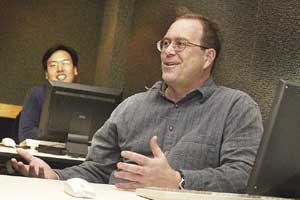2002 Quantrell Award Winner: Douglas MacAyeal, Professor in Geophysical Sciences and the College
By Steve KoppesNews Office
 Douglas MacAyeal |
“I came here from graduate school as an Assistant Professor, and the first class I ever taught was attended by two of my senior-professor faculty colleagues,” MacAyeal said. “That scared the liviní crap out of me.”
MacAyeal said the experience taught him to think on his feet, a skill that may have figured in his being named a recipient of the 2002 Quantrell Award for Excellence in Undergraduate Teaching. “Itís something Iím going to be really proud of for the rest of my life,” he said.
MacAyeal teaches Ice Age Earth in the undergraduate Core, along with two advanced undergraduate courses: Physical Oceanography and Inverse Methods in Geophysical Sciences.
One of MacAyeal’s techniques is to change the content of a course every time he teaches it. “It’s like the shark that has to keep swimming in order to stay afloat. For me to stay afloat in teaching, I have to constantly learn new material to teach to my students, or take on new challenges,” MacAyeal said.
MacAyeal also likes to connect his research to his teaching. Last year, WGN-TV weatherman Tom Skilling aired a story about MacAyeal’s Antarctic iceberg research. Skilling followed up with another story about MacAyeal’s daylong Ice Age Earth field trip.
“It gave me the opportunity to expose my class to this fun experience of doing a field trip with a journalist,” MacAyeal said.
The focus of the field trip was to view exposures in the Waterfall Glen Forest Preserve at Argonne National Laboratory of the now-relict river channels of the Chicago outlet, the former drainage path for the Great Lakes. “As recently as 2,000 years ago, the Great Lakes came through Chicago in their drainage to the Mississippi, rather than going through the St. Lawrence Seaway into the North Atlantic,” MacAyeal said.
The field trip enabled MacAyeal to teach his students about the connection between physical science and human affairs. Chicago’s settlers built a canal along that relict river channel because it formed the closest connection between the Mississippi River and the Great Lakes water transportation systems. “The building of that canal created the land boom in this area that blew the city into existence,” MacAyeal said.
In his Introduction to Inverse Methods course this quarter, MacAyeal makes use of the USITE/Crerar Computing Clusters classroom in the John Crerar Library. The course includes working on a famous calculation that converts data from a borehole drilled through the Greenland ice sheet into a history of past temperatures for the region.
“I actually go step-by-step through a calculation that was done as cutting-edge research only five years ago,” MacAyeal said.
MacAyeal walks his students through the calculation over the course of several weeks in what he refers to as “baby steps.” At the end, he and his students will have the satisfaction of having mastered a problem that initially seemed far beyond the scope of a typical undergraduate course.
“Instead of looking up to it as something on a pedestal, we’re actually doing it ourselves and starting to think of maybe even doing it in better ways,” he said.
![[Chronicle]](/images/small-header.gif)